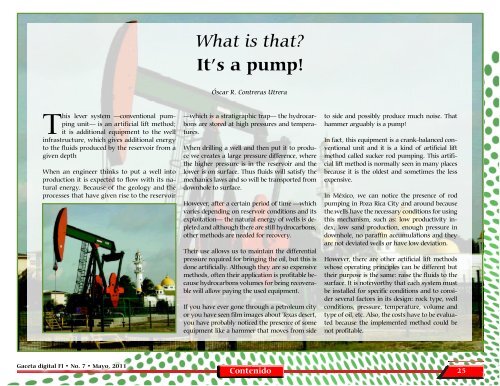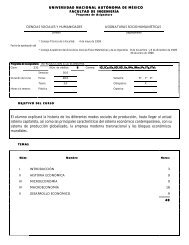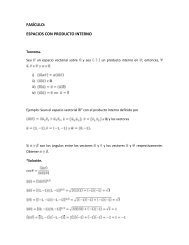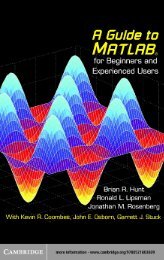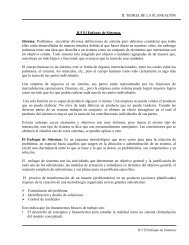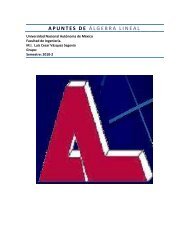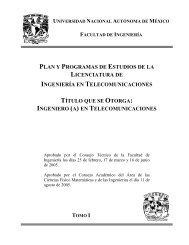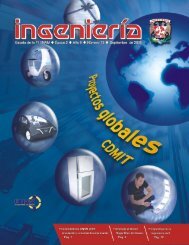En SEFI, unidos para alcanzar metas - Facultad de IngenierÃa - UNAM
En SEFI, unidos para alcanzar metas - Facultad de IngenierÃa - UNAM
En SEFI, unidos para alcanzar metas - Facultad de IngenierÃa - UNAM
Create successful ePaper yourself
Turn your PDF publications into a flip-book with our unique Google optimized e-Paper software.
What is that?<br />
It’s a pump!<br />
Óscar R. Contreras Utrera<br />
This lever system —conventional pumping<br />
unit— is an artificial lift method;<br />
it is additional equipment to the well<br />
infrastructure, which gives additional energy<br />
to the fluids produced by the reservoir from a<br />
given <strong>de</strong>pth<br />
When an engineer thinks to put a well into<br />
production it is expected to flow with its natural<br />
energy. Because of the geology and the<br />
processes that have given rise to the reservoir<br />
—which is a stratigraphic trap— the hydrocarbons<br />
are stored at high pressures and temperatures.<br />
When drilling a well and then put it to produce<br />
we creates a large pressure difference, where<br />
the higher pressure is in the reservoir and the<br />
lower is on surface. Thus fluids will satisfy the<br />
mechanics laws and so will be transported from<br />
downhole to surface.<br />
However, after a certain period of time —which<br />
varies <strong>de</strong>pending on reservoir conditions and its<br />
exploitation— the natural energy of wells is <strong>de</strong>pleted<br />
and although there are still hydrocarbons,<br />
other methods are nee<strong>de</strong>d for recovery.<br />
Their use allows us to maintain the differential<br />
pressure required for bringing the oil, but this is<br />
done artificially. Although they are so expensive<br />
methods, often their application is profitable because<br />
hydrocarbons volumes for being recoverable<br />
will allow paying the used equipment.<br />
If you have ever gone through a petroleum city<br />
or you have seen film images about Texas <strong>de</strong>sert,<br />
you have probably noticed the presence of some<br />
equipment like a hammer that moves from si<strong>de</strong><br />
to si<strong>de</strong> and possibly produce much noise. That<br />
hammer arguably is a pump!<br />
In fact, this equipment is a crank-balanced conventional<br />
unit and it is a kind of artificial lift<br />
method called sucker rod pumping. This artificial<br />
lift method is normally seen in many places<br />
because it is the ol<strong>de</strong>st and sometimes the less<br />
expensive.<br />
In México, we can notice the presence of rod<br />
pumping in Poza Rica City and around because<br />
the wells have the necessary conditions for using<br />
this mechanism, such as: low productivity in<strong>de</strong>x,<br />
low sand production, enough pressure in<br />
downhole, no <strong>para</strong>ffin accumulations and they<br />
are not <strong>de</strong>viated wells or have low <strong>de</strong>viation.<br />
However, there are other artificial lift methods<br />
whose operating principles can be different but<br />
their purpose is the same: raise the fluids to the<br />
surface. It is noteworthy that each system must<br />
be installed for specific conditions and to consi<strong>de</strong>r<br />
several factors in its <strong>de</strong>sign: rock type, well<br />
conditions, pressure, temperature, volume and<br />
type of oil, etc. Also, the costs have to be evaluated<br />
because the implemented method could be<br />
not profitable.<br />
Gaceta digital FI • No. 7 • Mayo, 2011<br />
Contenido 25


